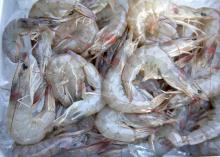Information Possibly Outdated
The information presented on this page was originally released on July 5, 2013. It may not be outdated, but please search our site for more current information. If you plan to quote or reference this information in a publication, please check with the Extension specialist or author before proceeding.
Hotter days help Gulf shrimp grow
BILOXI – More than 250 boats launched on June 11 to open the shrimp season in Mississippi’s coastal waters.
A cold, wet spring delayed the season’s start, which opened June 1 last year.
“The things farmers hate -- drought and heat -- are great for shrimp production,” said Dave Burrage, commercial and recreational fisheries specialist with the Mississippi State University Extension Service. “The brown shrimp don’t grow as fast under the conditions we had this spring, but once it gets hot, they can go up a whole count size in a week.”
Burrage said if conditions hold, this year’s shrimp crop is shaping up to be about the same as last year’s in terms of price and production costs.
In the first week of the season, shrimpers brought about half a million pounds of shrimp into the port in Biloxi, where most of the processing plants are located. That figure is a little lower than the first week last year, and the shrimp are smaller.
“To put this in context, last year the bulk of the shrimp were in the 41/50 range – between 41 and 50 shrimp per pound,” he said. “Because of the slow growth of the shrimp this year, most of the shrimp are in the 51/60 category.”
The price for the 41/50 size with heads on the shrimp is $1.40 per pound off the boat. The price for the 51/60s is $1.35 per pound.
“They’re catching the same amount of shrimp as last year, but with the smaller size, there’s less money for fishermen overall,” Burrage said. “There are 40 more boats working this year, but they still managed to catch less shrimp.”
Steve Bosarge has owned Bosarge Boats since 1978. He currently runs five trawlers and two work boats.
“From what I’ve seen, the season in Mississippi is well below average,” Bosarge said. “The weather conditions have not been conducive to shrimp production, and the shrimp started out small. The week after opening things got better, but now the harvest has dropped back -- there’s just not that many shrimp to be caught.”
Bosarge said spirits are down, and most fishermen are hoping for the shrimp to grow in size and in number as the season warms up.
“We just keep hoping the shrimp will grow,” he said. “At least 50 percent of the fishermen sell their catch right off the dock, and it’s easier to sell bigger shrimp.”
Burrage said one important bright spot is the unexpected early harvest of some very large white shrimp, which prefer less saline and the cooler conditions present this season.
“Typically the white shrimp show up mid-July to early August, and in two weeks last year, we caught 50,000 pounds of these bigger shrimp,” Burrage said. “In the first week this year, we caught about 90,000 pounds of the big, big shrimp -- the under 15s and the 16/20s. These biggest ones are for stuffing and baking.”
To capitalize on their bounty, many fishermen head these large shrimp onboard.
“The tails were bringing $5 a pound, and with heads on they were running about $3.50 a pound -- both better than the brown shrimp prices,” Burrage said.
Another boon to fishermen is the increased interest in buying local foods. Many seafood fans come to the docks and buy freshly caught shrimp right off the boat for about $3 a pound, a bargain compared to grocery store prices.
Burrage said the catch harvested by fishermen in the Gulf and south Atlantic states is only about 5 percent of what is consumed in the United States.
“Ninety-five percent of the shrimp eaten is imported,” he said. “Our fishermen have to compete with foreign imports, which may be subsidized. Dealing directly with consumers brings a higher price for their catch.”
Burrage said he has seen people arrive at the docks with several coolers in their trucks and buy 500 pounds of shrimp to supply their entire family with local shrimp.
“The fishermen get more money, the consumers are saving money, and some of the shrimp are still knocking around in the cooler – you can’t get them any fresher than that,” he said.





